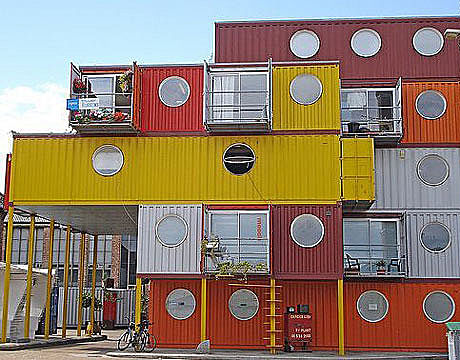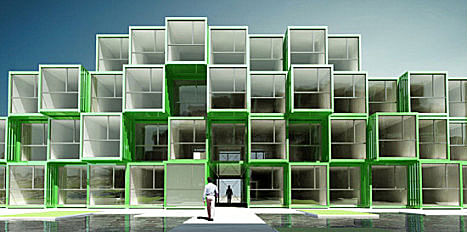

Shipping container architecture is fast becoming the hot new green trend for both designers and DIY’ers who want their own sustainable, chic home. My brother and his wife have asked me to design them a shipping container home and despite my familiarity with the topic I was pretty sure they knew more about it than I did. Like any good designer I began researching everything involved with designing and building a shipping container house and decided it was important to share what I found because there are some downsides that everyone embarking on a container house should be aware of.
Pros:
One of the main reasons that container architecture is becoming so popular is that sheer abundance of shipping containers available for purchase. It is estimated that around 100 million shipping container loads cross the ocean every year. The cost of building a new container is significantly cheaper than shipping them back to be re-filled and after a couple uses, they are no-longer desired by shipping companies and become unusable. They take up valuable space on the docks and can eventually become a source of pollution. Despite the extreme wastefulness of such a system, there is currently little or no imperative to figure out a more sustainable solution so it is up to the architects and designers to re-use the unwanted containers. Because of the ample supply of shipping containers, they can be purchased for a very reasonable price, some for as low as $900.
In addition to the availability and low-cost of containers, they are modular and versatile and can be arranged to suit any family arrangement. They can be used for a single family home or combined to create large scale student housing. They can be minimally fitted-out to provide emergency shelter or completely transformed into luxury accommodation. Since they are modular, projects can be designed to be easily taken apart, transported and re-built making them extremely adaptable. Furthermore, the shell is very resilient and can be used in any climate given proper insulation and ventilation are incorporated.


Cons:
While it is easy to get excited about the possibilities of container architecture, it is also important to fully understand the entire process of designing and building a container house to assess the ‘green-ness’ of the project. The first thing to consider is the distance your shipping containers will have to travel to get to the construction site. The Cordell Shipping Container House is a very attractive container home with many sustainable design features that produced only 10 garbage bags full of construction waste. However, the house is in Texas. How many shipping ports are there in Texas? The amount of fuel used to transport the containers from wherever they originated will certainly contribute to the overall ‘footprint’ of the design and take away from the overall green factor of the project. While this is certainly not a deal-breaker it is something to keep in mind when looking for shipping containers to buy.

Once you have the containers, they need to be made safe for residential use. These containers are exposed to some of the roughest environments on earth and have to be durable for ocean transport. They are coated with harmful chemicals to keep away pests and prevent rust among other things and have to be thoroughly stripped and cleaned before they can be used as houses.
After transportation and cleaning, the containers have to be transformed into a house. This process involves cutting windows and doors out of the metal, attaching two or more containers together horizontally or vertically and providing additional structural support. All of these adjustments can create nearly a thousand pounds of hazardous waste and when coupled with the fossil fuels required for transportation and heavy machinery to put the containers in place, there can be a fairly high ecological footprint associated with container houses.
Despite some of the drawbacks to shipping container houses, they are still a great example of ingenuity and certainly have significant potential as adaptive re-use projects. Perhaps they are best suited for emergency shelters where materials are scarce or larger scale mixed-use projects like Container City in London where the cleaning process can be streamlined to reduce waste.
Overall, shipping container architecture is a very exciting trend that has a lot of potential but it is important to be aware of the steps involved in the design and construction process in order to be able to minimize the ecological impact of your shipping container project. In the end, my brother and his wife live very near to one of the largest shipping ports in America so I will be designing them a container house. I will certainly be posting about my experience.
Useful Links:
http://www.shipping-container-housing.com/index.html
Images:
Crou Student Housing: http://zerocabin.com/
Redondo Beach House: http://demariadesign.com/1/index.php?option=com_content&view=article&id=52&Itemid=27
Cordell House: http://gliving.com/the-cordell-shipping-container-house/
A discussion on everything to do with sustainable design. From renewable energy to implementing integrated design in professional practice. Case studies, article reviews and green building certification methods and additional resources will all be included.
No Comments
Block this user
Are you sure you want to block this user and hide all related comments throughout the site?
Archinect
This is your first comment on Archinect. Your comment will be visible once approved.